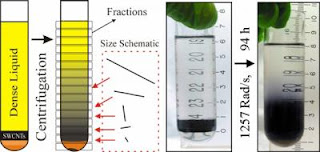Unfortunately, the methods for manufacturing carbon nanotubes always create a large percentage of nanojunk in the mix—clumps of carbon, ordinary soot, particles of metal used as a catalyst—and nanotubes come in an enormous range of lengths, from a few tens or hundreds, up to thousands of nanometers. Refining the lot is essential for most uses. For many potential applications, nanotubes need to be separated by length. In biomedical applications, for example, it has been shown that whether or not nanotubes are taken up in cells depends critically on length (see “Study: Cells Selectively Absorb Short Nanotubes.”) Nanotubes used as components in future microcircuits obviously need to fit in place, and in optical applications, a nanotube’s length determines how strongly it will absorb or emit light (see “Longer is Better for Nanotube Optical Properties.”)
In 2006, researchers found that you could separate nanotubes by “chirality” (a measure of the twist in the carbon atom sheet) by spinning them in a dense fluid in an ultracentrifuge tube because of a relationship between chirality and buoyancy. In this new work, a team of NIST researchers demonstrated that a variation of the same technique can separate nanotubes by length. They showed that while the nanotubes ultimately will move to a point of equilibrium in the centrifuge tube dictated by their buoyancy, due to friction they will move at different rates depending on their lengths.
“When we spin the centrifuge, it turns out that the longer ones move faster. We basically just run a race and the longer ones move farther in the same amount of time,” says researcher Jeffrey Fagan, “Eventually they get separated enough in position that we can just pull off layers and get different lengths.”
What’s particularly exciting, they say, is that while other techniques have been shown to sort nanotubes by length, this is the first approach that could be scaled up to produce commercially important quantities of nanotubes in a given length range. The process also removes much of unwanted junk—particularly metal particles—from the batch. NIST has applied for a patent on the process. ###
* J.A. Fagan, M.L. Becker, J. Chun and E.K. Hobbie. Length fractionation of carbon nanotubes using centrifugation. Advanced Materials. 2008. 20. 1609–1613.
Contact: Michael Baum michael.baum@nist.gov 301-975-2763 National Institute of Standards and Technology (NIST)















No comments:
Post a Comment